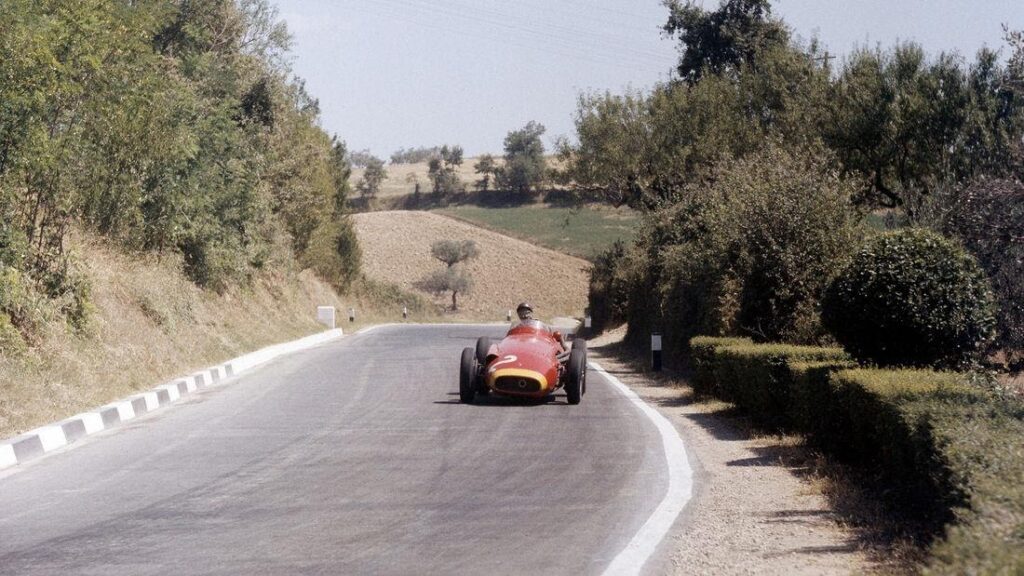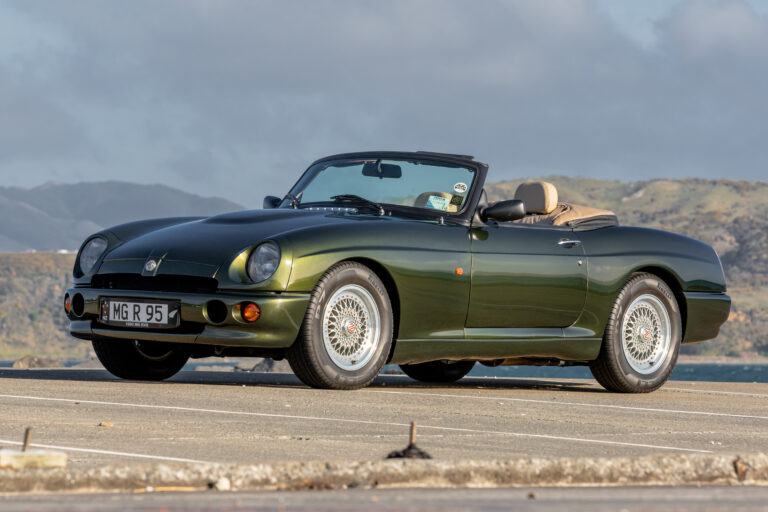In this geographically-focused Motorsport Flashback, Michael Clark explores the motoring legacy of Pescara
by Michael Clark

Denny Hulme’s victory in August 1960 wasn’t the only reason I was drawn to Pescara, Italy — though it was a contributing factor. There’s not another country that better combines my wife’s love for art with my mild obsession with the motor car; add in our shared fondness for history, architecture, beautiful scenery, food, and wine, and it isn’t hard to see why this Italian town is on the list.
The most famous Italian track is, of course, the Autodromo Nazionale di Monza that was completed in 1922. It remains Europe’s most famous theatre of speed but there are also other permanent circuits such as Mugello, Misano, Vallelunga, and Imola to indulge this nation of petrolheads. Comfortably pre-dating Monza, and even Brooklands and Indianapolis, was Sicily’s famous Targa Florio, but that was held on public roads on the ‘Madonie’ circuit — total lap length for the inaugural race in 1906 being a bracing 148.823km! But that was nothing alongside the Mille Miglia.
That was essentially a 1000-mile lap (between 1597 and 1609km) of central Italy over public roads held while the locals still went about their daily chores — children’s football games ‘on the racetrack’ being only temporarily suspended as cars sped by. It was complete madness, of course, and the inevitable end came in 1957, 30 years after the first, when not only three competitors died but nine spectators were also killed, including five children.

Not the end of the road
Abruptly both the Dutch and Belgian Formula 1 Grands Prix were cancelled, although it was the high price of fuel as a result of the Suez Crisis that was popularly cited as the reason. This provided an opening for a new race to be added into the world championship reckoning and organisers of the annual race at Pescara put their hands up.
The first race had been held there in 1924 and non-championship F1 events had been part of the calendar since the early 1950s — but now Pescara had a chance to make history. The 1957 season had been intriguing as Juan-Manuel Fangio had left Ferrari at the end of 1956 with the only positive memory being the picking up of his third world championship title. When Stirling Moss, in a patriotic rush of blood, chose to leave Maserati and join Vanwall, Fangio happily took the seat of the No.1 250F. The Argentinian would certainly have enjoyed chasing down the Ferraris of Mike Hawthorn and Peter Collins to take his most remembered, if not necessarily most outstanding, victory.
Moss and Collins had shared the winning Vanwall at Silverstone to give the marque an emotionally charged debut win on home soil but Fangio’s dramatic win in Germany also gave him his fifth world title.
The final round would be at Monza on the traditional early September date and so the ‘Pescara Grand Prix’ would be slotted in between the German and Italian GPs. The event had enough milestones to warrant its own section in any car club trivia night. For a start, it was the first and last time two consecutive rounds of the F1 world championship were held in a calendar year in the same country, and it was the last time a road course — as opposed to a ‘round the houses’ type street circuit — was used as part of the title chase. And, at 25.579km around, it remains the longest track ever used in the world championship, easily eclipsing the Nurburgring’s Nordschleife (North Loop), that weighs in at 22.810km.
Like Nurburgring and Belgium’s Spa-Francochamps, Pescara’s circuit was extraordinarily challenging and unbelievably dangerous, so much so that for the 1957 world championship round, Ferrari elected not to send cars on account of the unnecessary risks. As with many significant decisions from Ferrari, there is invariably a back story. Enzo Ferrari wasn’t known for failing to send cars simply because a track was considered dangerous — in fact, it was a place he knew well, having won the inaugural event in 1924 when he was a driver on the Alfa Romeo squad.
More likely is the fact that with Fangio already champion-elect, he saw nothing to be gained by doing back-to-back races in the same country — especially because it gave the team more time to prepare his cars for the big prize at Monza.

In Denny’s tyre tracks
For the record, Moss won both races in Italy, meaning that he was yet again runner-up to Fangio in the drivers’ championship. Pescara meanwhile went into a two-year hibernation for any motor racing as even the Italians came around to thinking it was too dangerous — certainly for F1 irrespective of whether the result counted towards the world championship. The end came in 1961 after a four-hour sports-car race but the final Gran Premo di Pescara was for Formula Juniors in 1960. That and the fact that a Kiwi had been the victor — and on such a circuit — made it a ‘must visit’.
The circuit’s shape is roughly triangular with the third line drawn during heavy turbulence. Pescara’s population is just shy of 120,000 making it the biggest city of the Abruzzo region. Located on Italy’s Adriatic (right hand) coast you can stand on the seafront and look across to Dubrovnik at the southern end of Croatia. Pescara, from which the track derived its name, is at the southern end of the six-kilometre-long straight along the coast from Montesilvano, a delightful town with a long flat sandy beach. It was from here that the clockwise re-tracing of Denny’s tyre tracks commenced, heading towards Pescara and wondering at what speed a 1-litre BMC-powered Cooper went this way. At Pescara we turn right. The Marina quickly disappears in the rearview mirror as we encounter corners for the first time — well, curves at least.
In front are the Abruzzo mountains. Up to the town of Villa Raspa we go but soon after it becomes seriously twisty as we approach Aperto and then Spoltore which places us 185 metres above sea level — the highest point. These roads look more suited to a rally special stage than Denny’s 75Kw Cooper, let alone some 200Kw of Maserati 250F or Vanwall. Then the asphalt narrows alarmingly through the little village of Cappelle sul Tavo and we picture those cars bellowing between buildings that certainly look like they were built well before the 1950s.
The tight right-hander marks the end of the squiggly bits and we commence the mostly-straight run back down to Montesilvano. You wonder how you’d gear a car for such extremes as this, and how many retirements were caused by over-revving or simply engines just crying ‘enough already!’ The answer is that seven of the 16 starters in 1957 finished with three retirements as a result of ‘engine’ and a further two being ‘oil leak’ a — regular euphemism proffered by teams for a hole punched through the side of the block.
When Denny arrived at Pescara in August 1960, accompanied by his friend Bill Gavin, he was still smarting at his distant second-place finish a couple of weeks earlier at Messina, another longish road circuit — albeit just 6.2 kilometres — around the Ganzirri Lake at the north-eastern tip of Sicily. Gavin, then a holidaying but aspiring journalist, recalled the entry for that race being split in two. Denny had won the second heat but as Bill told me, “his time for the heat wasn’t quite as fast as Colin Davis who won the first heat but he was still hopeful for the final.” But the Italy-based Englishman also prevailed in the final which made Denny “… extremely determined for Pescara.”

Denny’s breakthrough
Again, two heats — each over just three very long laps. Denny paced himself beautifully and finished second to Lorenzo Bandini. Davis won his heat from Argentinean Jean-Manuel Bordeu and another Italian who would win in F1 for Ferrari, Ludovico Scarfiotti. The final, on 15 August 1960, was over seven laps. Also in the final were future F1 drivers John Love from Rhodesia and Giancarlo Baghetti but no one could touch the Kiwi. “He was outstanding and although I had suspected before then that he might have F1 potential, that was the race that convinced me how good Denny was. It was probably his biggest win at that time, and it didn’t go unnoticed,” says Gavin.
None other than Juan-Manual Fangio presented Denny with the trophy and as Bill recalled: “Denny handed him his autograph book in which Fangio wrote some nice words that roughly translate to ‘To the very clever winner of the Grand Prix of Pescara.’ We left straight after prize giving, heading back to England, I was driving when we both woke up doing about 70 miles an hour in a ditch.” Shortly after returning from the ditch, Denny, George Lawton, and manager Feo Stanton headed for Scandinavia. Bill had never intended going as he continued his quest to break into the world of motor racing journalism but, even six decades on, he recalls the emotion of learning of George’s death in Denmark. “It was devastating — Feo asked me to phone George’s father in Whangarei. Gosh that was hard …”
A month after his big win in Italy, Denny made his F1 debut in a non-championship race at Snetterton where he finished fifth in the Yeoman Credit Cooper. That ride had been intended for fellow Kiwi ‘Driver to Europe’ in 1960 Lawton — a talent that sadly never had the opportunity to blossom on the world stage.
In mentioning Italian racetracks, it is forty years since the only official Italian Grand Prix that was not held at Monza. In 1980 the famous Autodrome was being refurbished and so the F1 fraternity assembled some 270km to the south-east at Imola, near Italy’s ‘food capital’, Bologna. The Italians had been angling for a second GP for some time and having staged a successful race at Imola in September 1980, a new GP was introduced in 1981, named after the small principality a further 100km to the south-east. The ‘San Marino Grand Prix’ had an unbroken run at Imola until 2006 but will forever be associated as the track where Ayrton Senna was killed in 1994.
As a matter of interest, this is not the only example of a Grand Prix being held away from the nation it is named after. Since motor racing was banned in Switzerland following the Le Mans disaster in 1955, the Swiss Grand Prix has been held in France, twice, while in 1997 and ’98 the Luxembourg Grand Prix was held in nearby Germany. It begged the question of how the second of ‘back to back’ GPs planned for 2020’s post-COVID abbreviated F1 season might be styled. Well, we now have an answer. The second race in Austria will be the Styrian GP, while a week after, the British will be back at Silverstone for — not the Scottish or the Welsh — but the ‘Anniversary Grand Prix’, where inevitably we’ll be told, incorrectly, that it’s 70 years since the birth of Formula 1. Don’t believe it!



